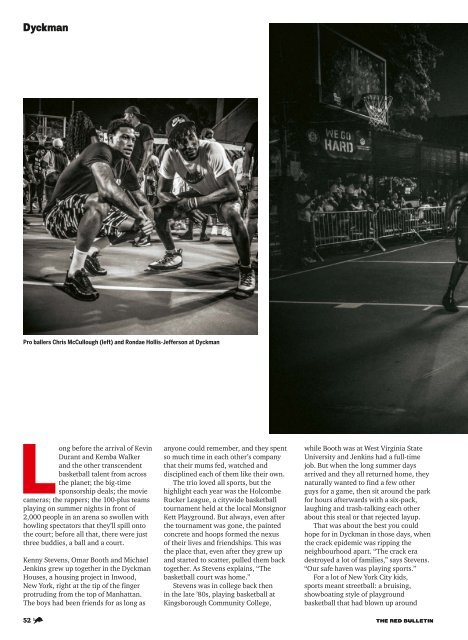Create successful ePaper yourself
Turn your PDF publications into a flip-book with our unique Google optimized e-Paper software.
Dyckman<br />
Pro ballers Chris McCullough (left) and Rondae Hollis-Jefferson at Dyckman<br />
Long before the arrival of Kevin<br />
Durant and Kemba Walker<br />
and the other transcendent<br />
basketball talent from across<br />
the planet; the big-time<br />
sponsorship deals; the movie<br />
cameras; the rappers; the 100-plus teams<br />
playing on summer nights in front of<br />
2,000 people in an arena so swollen with<br />
howling spectators that they’ll spill onto<br />
the court; before all that, there were just<br />
three buddies, a ball and a court.<br />
Kenny Stevens, Omar Booth and Michael<br />
Jenkins grew up together in the Dyckman<br />
Houses, a housing project in Inwood,<br />
New York, right at the tip of the finger<br />
protruding from the top of Manhattan.<br />
<strong>The</strong> boys had been friends for as long as<br />
anyone could remember, and they spent<br />
so much time in each other’s company<br />
that their mums fed, watched and<br />
disciplined each of them like their own.<br />
<strong>The</strong> trio loved all sports, but the<br />
highlight each year was the Holcombe<br />
Rucker League, a citywide basketball<br />
tournament held at the local Monsignor<br />
Kett Playground. But always, even after<br />
the tournament was gone, the painted<br />
concrete and hoops formed the nexus<br />
of their lives and friendships. This was<br />
the place that, even after they grew up<br />
and started to scatter, pulled them back<br />
together. As Stevens explains, “<strong>The</strong><br />
basketball court was home.”<br />
Stevens was in college back then<br />
in the late ’80s, playing basketball at<br />
Kingsborough Community College,<br />
while Booth was at West Virginia State<br />
University and Jenkins had a full-time<br />
job. But when the long summer days<br />
arrived and they all returned home, they<br />
naturally wanted to find a few other<br />
guys for a game, then sit around the park<br />
for hours afterwards with a six-pack,<br />
laughing and trash-talking each other<br />
about this steal or that rejected layup.<br />
That was about the best you could<br />
hope for in Dyckman in those days, when<br />
the crack epidemic was ripping the<br />
neighbourhood apart. “<strong>The</strong> crack era<br />
destroyed a lot of families,” says Stevens.<br />
“Our safe haven was playing sports.”<br />
For a lot of New York City kids,<br />
sports meant streetball: a bruising,<br />
showboating style of playground<br />
basketball that had blown up around<br />
52 THE RED BULLETIN

















